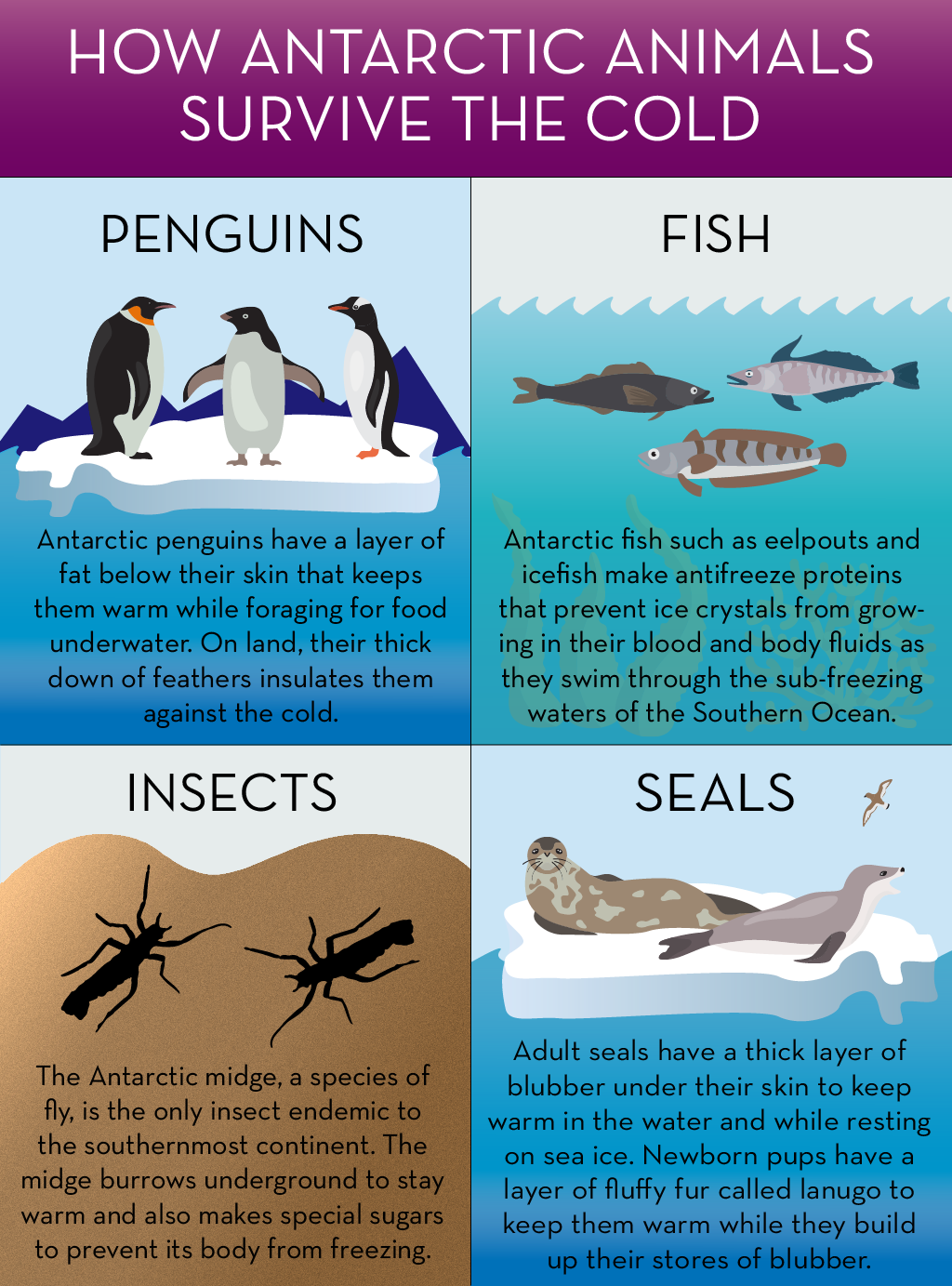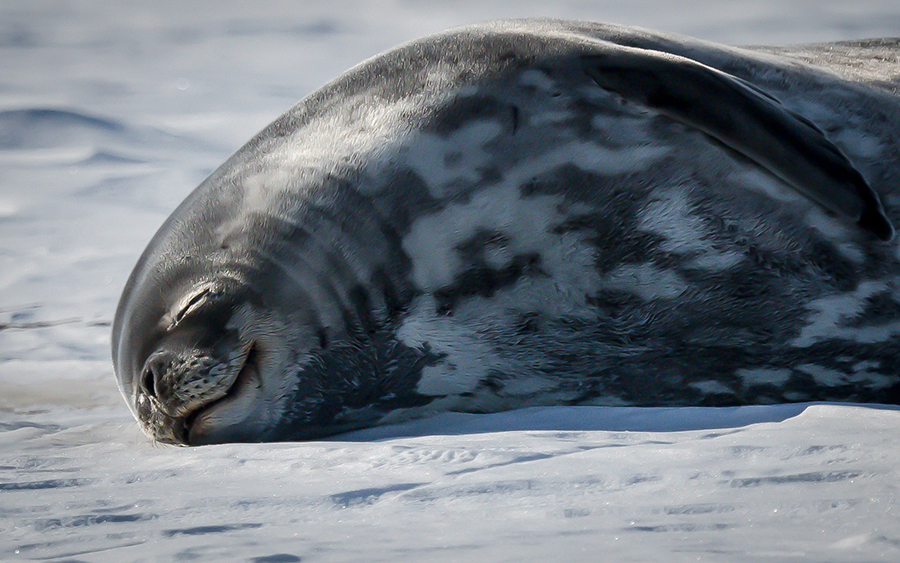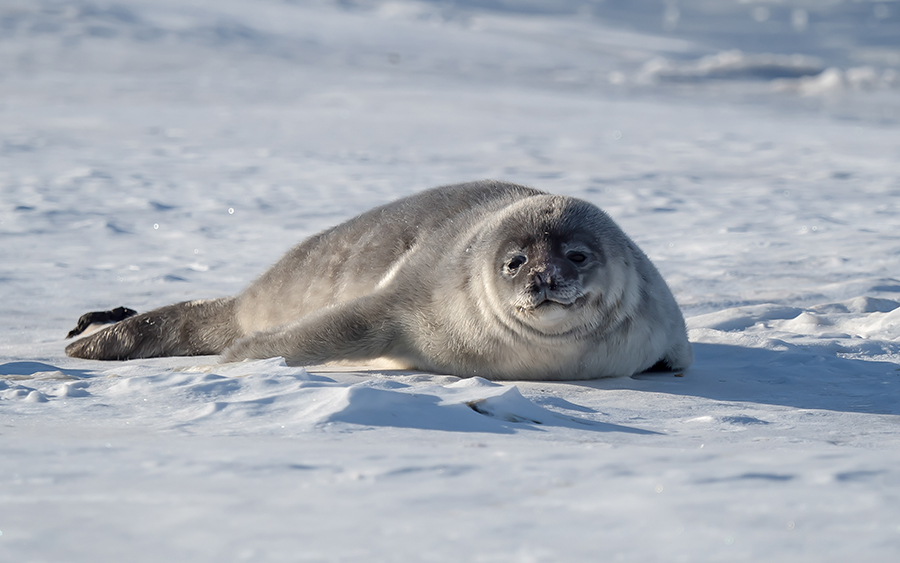Genetics reveals how fish and seals adapt to Antarctic coldResearchers find unique genetic machinery that allow animals to survive on and near the southernmost continentPosted August 29, 2022
New research into seal and fish genomes is giving scientists clues to how these hardy animals evolved to survive the extreme cold of Antarctica and the Southern Ocean. A study published earlier this year shows Weddell seals express genes that make them particularly adept at transporting fat molecules throughout their bloodstream without suffering from cardiovascular disease. This is an important physiological process that allows Weddell seals to build up a thick layer of blubber to keep warm and allows nursing mothers to produce fat-rich milk their growing pups need to survive. 
Graphic by Lauren Lipuma.
This graphic shows how different types of animals survive the cold of Antarctica.
The results help scientists understand how Weddell seals evolved to be the southernmost breeding mammal on Earth and may have implications for treating some human cardiovascular diseases. “If we can understand how seals do what they do, and how that's different from humans, I think that has real powerful implications for how we can treat diseases in humans that seals naturally experience, but don't suffer negative consequences from,” said Allyson Hindle, a biologist at the University of Nevada Las Vegas and co-author of the new study. Another recent study on eelpout, ray-finned fish that somewhat resemble eels, finds two groups of Antarctic fish have similar adaptations to survival in subfreezing water but evolved those adaptations through different genetic mechanisms. The findings help researchers understand how resilient these fish may be to warming of the Southern Ocean due to climate change. “That tells us about the fact that how evolution proceeds is largely not predictable,” said Joanna Kelley, a biologist at Washington State University and co-author of the study. “But I also think it tells us that when we're thinking about how climate change may affect these species… each clade needs to be treated differently and we can't treat everything the same.” A unique way of transporting lipidsScientists have long been interested in how animals have adapted to the harsh Antarctic environment. Recent advances in genome sequencing have allowed researchers to map these animals’ genetic machinery for the first time, helping scientists understand the mechanisms that allow animals to survive in extreme conditions. Weddell seals are particularly interesting to scientists because of their unique physiology. Weddell seals would be considered morbidly obese by human standards; they have a thick layer of blubber under their skin and carry higher levels of cholesterol in their blood than many other mammals. In humans, high cholesterol levels restrict blood flow and impact blood vessel health, increasing a person’s risk of heart attack or stroke. But seals can have cholesterol levels up to 10 times higher than humans without suffering any cardiovascular disease. In Allyson Hindle’s recent study, she and her colleagues used genetic material collected from Weddell seals living in Erebus Bay, Antarctica to sequence the animal’s genome for the first time. They then compared the results to the genomes of other seals and other mammals, including humans. The researchers found Weddell seals have genetic adaptations that allow them to survive with high lipid levels in their bloodstream. Humans use two molecules to carry lipids (particularly cholesterol) through their bloodstream: low-density lipoprotein, or LDL, and high-density lipoprotein, or HDL. In general, HDL is protective to the cardiovascular system but LDL is destructive: the greater proportion of LDL a person has in their blood, the greater their risk of cardiovascular disease. The new study shows Weddell seals have a unique medium-to-high-density lipoprotein that carries all of their blood cholesterol. This protein is found in no other animal species that the researchers investigated, suggesting it may be important in how seals are able to survive with so much fat in their blood and transport it so easily. “We can predict this is very different from humans, and this is even very different from other mammals that aren't humans,” Hindle said. “We don't know what it means, but it seems like a really good thing to follow up on because this seems to be really different in seals, and this could explain their really extreme physiology.” Different evolutionary journey, same destinationBiologists are also interested in studying how fish evolved to survive in the Southern Ocean, where water temperatures are often below freezing. So far, most of this research has focused on notothenioids, more commonly known as icefish. Icefish live only in the Antarctic and are unique among animals in that they produce no hemoglobin, the protein that transports oxygen through blood. In Joanna Kelley’s new study, her team was interested in studying eelpout, a cosmopolitan group of fish found all over the world, including Antarctica. They wanted to know whether eelpouts’ genetic adaptations to cold water overlap with those of icefish. Evolutionarily speaking, “Icefish have done a bunch of weird stuff,” said Scott Hotaling, a biologist at Utah State University and lead author of the new study. “We wanted to know: Is that weird stuff general? Or is that weird stuff unique to the icefish?” The researchers collected DNA from eelpouts caught near the West Antarctic Peninsula and sequenced the fish’s genome for the first time. The results show eelpouts and icefish share similar adaptations to life in the Southern Ocean, but the two groups evolved those adaptations differently. Specifically, both groups of fish make antifreeze proteins that prevent ice crystals from growing in their blood and have vision tailored to extreme darkness, but their genetic makeup is different. “For eelpouts, the take-home is they have their own unique way of doing it,” Hotaling said. “They have found their way of living in Antarctica that is different than icefish. So what icefish do is unique to icefish, and icefish are not a general rule of polar adaptation.” The results showed eelpouts do make hemoglobin, unlike icefish, but they have fewer hemoglobin genes than other fish do. The Southern Ocean has more dissolved oxygen than other areas of the planet, so hemoglobin may not be as critical a protein to fish living there. “If you don’t need something, selection will often purge or remove or it'll get modified by random chance,” Hotaling said. “There’s nothing keeping it intact for your survival.” This research is supported by the National Science Foundation, which manages the U.S. Antarctic Program. NSF-funded research in this story: Allyson Hindle, University of Nevada Las Vegas, awards 1443554 and 1921491; John Postlethwait, University of Oregon, awards 1543383 and 1947040; and Joanna Kelley, Washington State University, award 1906015. All Weddell seal handling and tissue collection were conducted under scientific authorizations from the National Marine Fisheries Service (NMFS 87-1851 & 19439) and the Antarctic Conservation Act. All eelpout procedures were performed according to protocols approved by the Institutional Animal Care and Use Committees (IACUC) of the University of Oregon (#13-27RRAA). |
"News about the USAP, the Ice, and the People"



For USAP Participants |
For The Public |
For Researchers and EducatorsContact UsU.S. National Science FoundationOffice of Polar Programs Geosciences Directorate 2415 Eisenhower Avenue, Suite W7100 Alexandria, VA 22314 Sign up for the NSF Office of Polar Programs newsletter and events. Feedback Form |



